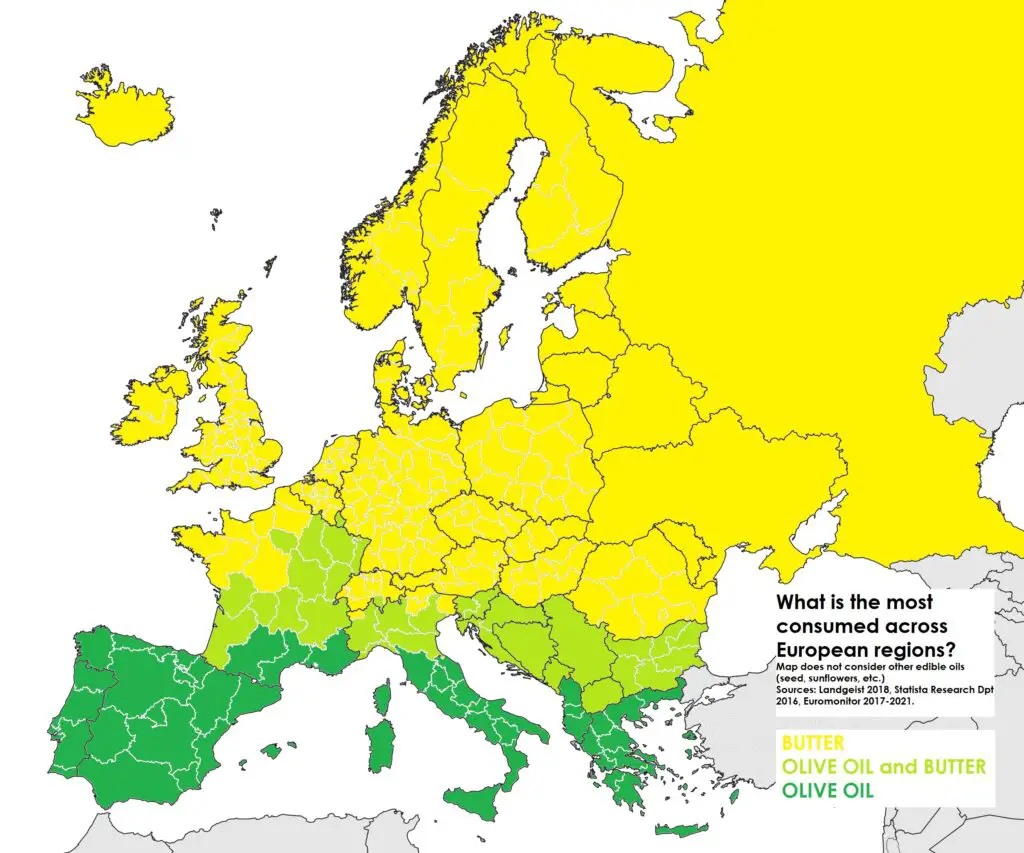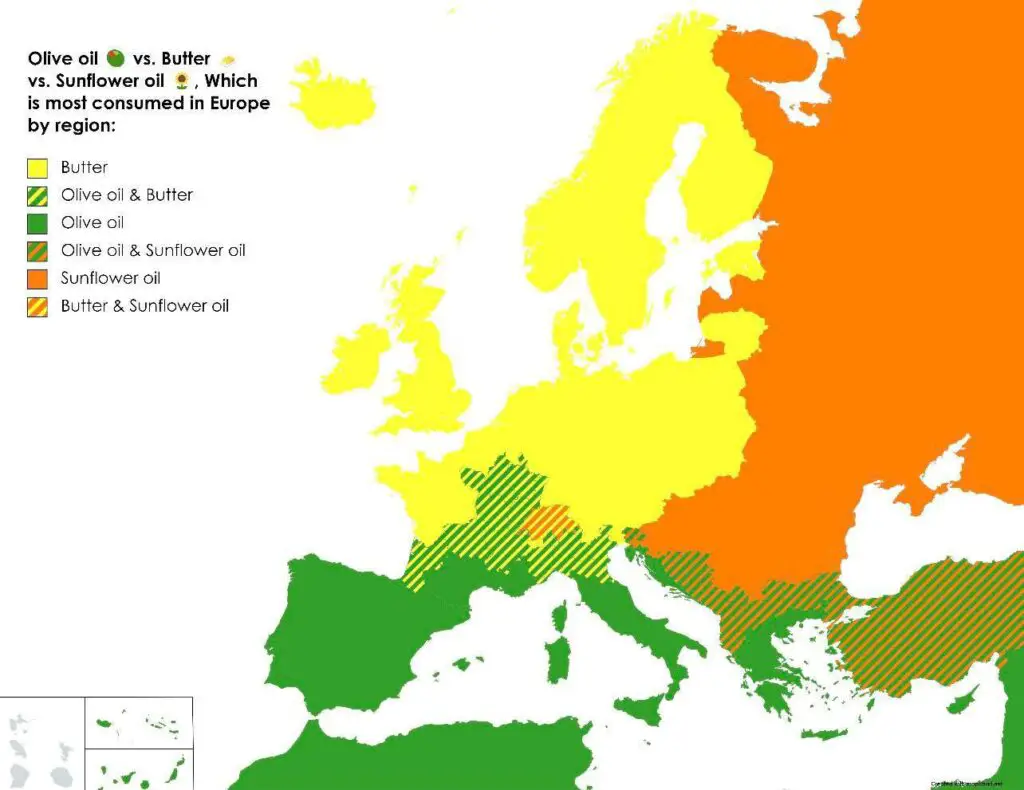Oil Consumption in Europe: Olive oil vs Butter vs Sunflower oil
Olive, butter, corn, and sunflower oils are all commonly used cooking oils, each with its own unique characteristics and culinary applications. In 2022, about 18.7 million barrels of oil daily were consumed in Europe.
Table of Contents
Olive Oil
Olive oil is derived from pressing olives and comes in various grades, such as extra virgin, virgin, and regular (refined) olive oil. It’s known for its rich flavor and health benefits. Olive oil is commonly used for:
- Sautéing and Pan-Frying: Olive oil is excellent for sautéing vegetables and meats at medium heat.
- Salad Dressings: Extra virgin olive oil is commonly used in dressings and vinaigrettes.
- Low-Heat Cooking: It’s suitable for light frying, such as cooking eggs.
- Flavor Enhancer: Used as a base for marinades, dips, and sauces.
Advantages
- Rich Flavor: Olive oil adds a distinct, rich flavor to dishes.
- Potential Health Benefits: Extra virgin olive oil is rich in antioxidants and monounsaturated fats, which may have heart-healthy effects.
- Versatility: Suitable for both savory and sweet dishes.
Disadvantages
- Low Smoke Point: Olive oil has a lower smoke point, making it unsuitable for high-heat cooking.
- Flavor Intensity: The strong flavor might not work well with all dishes.
Butter
Butter is made from churning cream or milk solids from animals like cows. It’s widely used for its rich, creamy taste and ability to add flavor to dishes. Butter is used for:
- Sautéing and Pan-Frying: Adds a rich, creamy flavor to foods.
- Baking: Essential for baked goods due to its flavor and texture.
- Finishing Touch: Adds velvety texture and enhances flavor in sauces and dishes.
- Flavor Enhancer: Used to enrich sauces, vegetables, and meats.
Advantages
- Rich Flavor: Butter imparts a delicious taste to dishes.
- Texture Enhancement: It improves the mouthfeel of foods.
- Baking Excellence: Provides tenderness and flavor to baked goods.
Disadvantages
- High in Saturated Fat: Butter contains saturated fat, which, in excess, might have health implications.
- Low Smoke Point: Unsuitable for high-heat cooking due to its low smoke point.
- Dairy Allergies: Not suitable for those with dairy allergies.
The use of different types of oil in European countries can be influenced by factors such as climate, agricultural practices, and culinary traditions. Olive oil, as opposed to butter, is closely associated with the Mediterranean region and is a staple in Mediterranean cuisine. The map below created by Reddit user ArthurEwert shows Olive oil vs. butter usage in Europe.

In addition to olive oil and butter, sunflower oil is also widely used for cooking.
Sunflower Oil
Sunflower Oil Sunflower oil is extracted from sunflower seeds and is neutral in flavor. It’s a versatile oil with a high smoke point. Sunflower oil is used for:
- Deep Frying: Suitable for deep frying due to its high smoke point.
- Stir-Frying: Works well for high-heat stir-frying.
- Baking: Used in baking to retain moisture and create a light texture.
- General Cooking: Its neutral flavor makes it versatile for various cooking methods.
Advantages
- High Smoke Point: Ideal for high-temperature cooking.
- Neutral Flavor: Doesn’t overpower the taste of dishes.
- Nutritional Profile: Contains vitamin E and unsaturated fats.
Disadvantages
- Omega-6 Content: Excessive consumption of oils high in omega-6 fatty acids without balancing with omega-3s might not be ideal for health.
- Refined Versions: Highly refined sunflower oils might have reduced nutritional value.

But it’s not just olive oil, butter, and sunflower oil that are used for cooking worldwide.
Corn Oil
Corn oil is not as commonly used for cooking in Europe compared to some other cooking oils like olive oil, sunflower oil, and rapeseed oil. While it might not be a staple in European cuisines, corn oil can still be found and used in various European countries for specific cooking purposes.
Corn oil is extracted from the germ of corn kernels and has a mild flavor. It has a higher smoke point compared to some other oils, making it suitable for higher heat cooking. Corn oil is used for:
- Frying: Suitable for deep frying and pan-frying due to its high smoke point.
- Stir-Frying: Works well for stir-frying at high temperatures.
- Baking: Can be used in baked goods for a neutral flavor and moisture retention.
- Marinades and Dressings: Its mild taste works as a base for dressings and marinades.
Advantages
- High Smoke Point: Corn oil’s high smoke point makes it suitable for high-heat cooking methods.
- Neutral Flavor: Its mild taste works well with various dishes.
- Versatility: Can be used for frying, baking, and cooking.
Disadvantages
- Nutritional Balance: Some corn oils might have a high omega-6 fatty acid content, which should be balanced with omega-3 intake.
- Refined Versions: Highly refined corn oils might lose some of their nutritional benefits.
Other types of cooking oils
- Canola Oil: Canola oil is a versatile and neutral-flavored oil that has a relatively high smoke point. It’s suitable for a variety of cooking methods, including sautéing, frying, baking, and dressings.
- Coconut Oil: Coconut oil has a unique flavor and is often used in baking, as well as in dishes that benefit from its tropical taste. It has a relatively high smoke point and is also used in some frying methods.
- Peanut Oil: Peanut oil has a high smoke point and is often used for deep frying due to its stability at high temperatures. It has a mild flavor that works well with many dishes.
- Sesame Oil: There are two types of sesame oil: toasted and untoasted. Toasted sesame oil has a strong nutty flavor and is usually used as a finishing oil, while untoasted sesame oil is used for cooking, particularly in Asian cuisine.
- Grapeseed Oil: Grapeseed oil has a high smoke point and is commonly used for high-heat cooking methods like frying and sautéing. It has a neutral flavor.
- Avocado Oil: Avocado oil has a high smoke point and a mild, slightly buttery flavor. It’s often used for high-heat cooking, as well as in salads and dressings.
- Safflower Oil: Safflower oil has a high smoke point and a neutral flavor. It’s suitable for frying, sautéing, and baking.
- Vegetable Oil: This is a general term that refers to a blend of various vegetable-based oils. It’s often used in commercial food preparation and home cooking for its neutral flavor and versatility.
- Flaxseed Oil: Flaxseed oil is often used as a finishing oil due to its strong nutty flavor and sensitivity to heat. It’s rich in omega-3 fatty acids.
- Walnut Oil: Walnut oil has a rich, nutty flavor and is typically used as a finishing oil for salads, pasta, and other dishes.
- Rice Bran Oil: Rice bran oil has a high smoke point and is commonly used in Asian cooking for stir-frying and deep frying.
- Hemp Oil: Hemp oil is derived from hemp seeds and has a strong, nutty flavor. It’s often used as a drizzling oil for salads and other cold dishes.
And if you’re looking to buy oil for cooking, you can still find it on Amazon:








